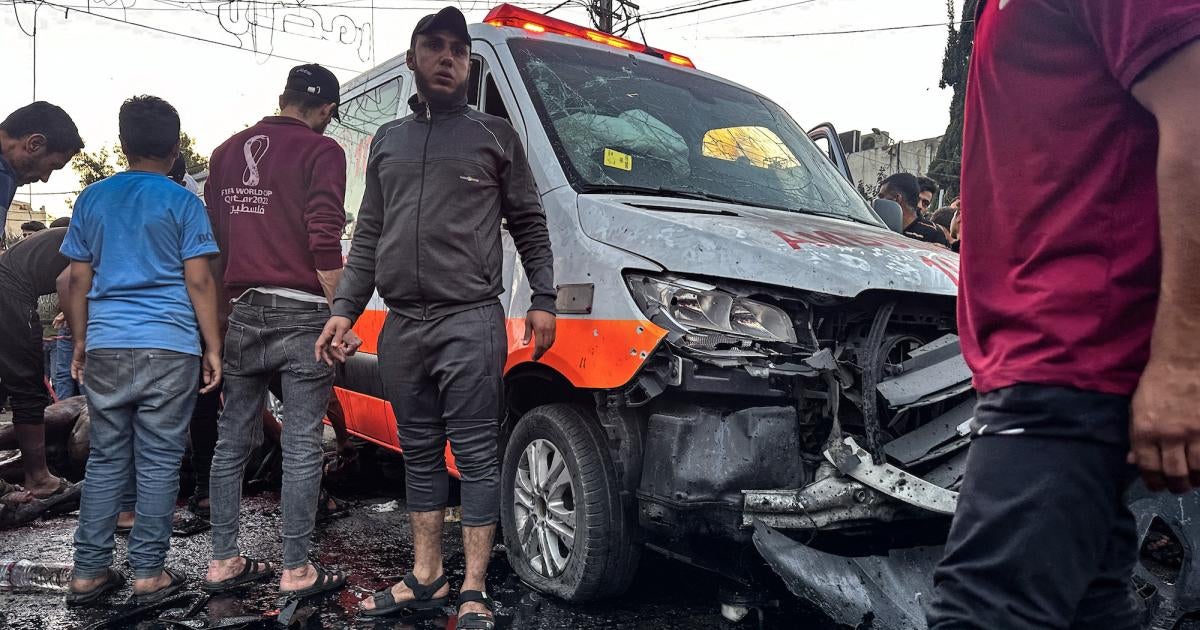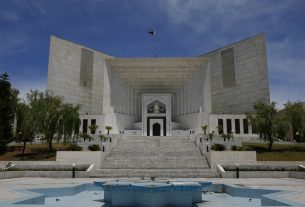(Jerusalem) – The Israeli military’s strike on a marked ambulance just outside of Gaza City’s al-Shifa hospital on November 3, 2023, was apparently unlawful and should be investigated as a possible war crime, Human Rights Watch said today. Video footage and photographs taken shortly after the strike and verified by Human Rights Watch show a woman on a stretcher in the ambulance and at least 21 dead or injured people in the area surrounding the ambulance, including 5 children.
An Israel Defense Forces spokesperson said in a televised interview that day that: “Our forces saw terrorists using ambulances as a vehicle to move around. They perceived a threat and accordingly we struck that ambulance.” International humanitarian law applicable to the armed conflict between Israel and Palestinian armed forces provides that ambulances used exclusively for medical transportation must be respected and protected in all circumstances, and only lose their protection if being used to commit acts harmful to the enemy.
“The need to safely transport wounded people to hospitals is critical in armed conflicts, so the laws of war provide special protections for ambulances used solely for this purpose,” said Lama Fakih, Middle East and North Africa director at Human Rights Watch. “For the Israeli authorities to claim that their deadly November 3 attack on an ambulance in a crowded area was lawful, they need to do more than just insist that Palestinian fighters were using an ambulance as transport.”
Gaza’s Health Ministry reported that 15 people were killed and 60 injured in the strike. The Palestine Red Crescent Society said that its ambulance was transporting a 35-year-old woman with fragmentation wounds to al-Shifa hospital, and that a medic and ambulance driver were injured in the strike. The director of the al-Quds hospital, which is under Palestinian Red Crescent Society auspices, told Human Rights Watch that the Israeli military provided no warning prior to the strike.
Human Rights Watch interviewed one witness to the strike and verified videos and photographs of the damaged ambulance and surrounding area taken after the strike, which occurred just before 4:30 p.m local time. on a busy street a few meters from the emergency department entrance to al-Shifa hospital. These videos and photographs, uploaded to social media or captured by journalists from media companies soon after the strike, show at least 21 wounded and dead people, including at least 5 children, 3 women, and 13 men. A horse, which was pulling a cart behind the ambulance, also appears to be dead.
In one video, uploaded to social media at 4:41 p.m., people tend to wounded and dead people who are scattered on the ground next to the ambulance in pools of blood. Another video, uploaded at 4:47 p.m., shows the same scene as well as the inside of the ambulance, where a woman in a hospital gown and medical hair net is visible lying on a stretcher. She does not appear to have been injured in the strike.
Ali Jadallah, a photographer, told Human Rights Watch by phone that he saw a missile hit directly in front of an ambulance that was driving toward al-Shifa hospital’s emergency department entrance. He said the strike wounded his sister in her legs.
“I rushed toward people injured and killed, looking for my sister,” Jadallah said. “I couldn’t find her, couldn’t see because there was so much smoke. I was shouting her name. People opened the door of the ambulance to check on the people inside and I saw a woman lying down inside. The driver was injured.”
International humanitarian law, or the laws of war, requires warring parties to collect and care for the wounded and sick. Ambulances, like hospitals, have special protection. They may not be targeted if being used to provide medical care of any kind, including to treat enemy fighters.
Ambulances and other medical transportation must be allowed to function and be protected in all circumstances. They must be presumed to be civilian and lose their protection only if they are being used to commit “acts harmful to the enemy,” such as transporting ammunition or healthy fighters. Using an ambulance for military operations would raise grave concerns for the safety of patients and medical workers in violation of the laws of war.
Human Rights Watch did not find evidence that the ambulance was being used for military purposes, however.
Should medical transport be misused, attacking forces must issue a warning to cease this misuse, and can only attack after such a warning goes unheeded. While the warning requirement must be strictly interpreted, there may be circumstances in which a warning is not required because of the immediate need for attacking forces to defend themselves.
Commentary from the International Committee of the Red Cross states that “[s]uch a decision can only be allowed on an exceptional basis, in the extreme circumstances of an immediate threat to the lives of advancing combatants, where it is clear that a warning would not be complied with.”
Parties to a conflict must take all feasible precautions to ensure that a target of attack is a military objective and not a civilian object. Attacks intentionally targeting civilians or civilian objects or where there is no military objective are prohibited. Given the apparent high number of civilian casualties, this attack may have been unlawfully disproportionate even if there was a valid military target. An attack is disproportionate if the expected loss of civilian life would be excessive compared with the concrete and direct military advantage anticipated.
Individuals who order or carry out unlawful attacks willfully – that is, deliberately or recklessly – are responsible for war crimes. Countries are obligated under the laws of war to investigate alleged war crimes and prosecute those responsible.
The United Nations Human Rights Council’s Independent International Commission of Inquiry on the Occupied Palestinian Territory, including East Jerusalem, and Israel, should investigate the attack, Human Rights Watch said. On October 10, the Commission of Inquiry noted there was “clear evidence” of war crimes in Israel and Gaza and that it would share information with relevant judicial authorities, especially the International Criminal Court (ICC).
The ICC prosecutor has jurisdiction over the current hostilities between Israel and Palestinian armed groups that covers unlawful conduct by all parties. The ICC’s Rome Statute prohibits as a war crime “[i]ntentionally directing attacks against … medical units and transport.” Israeli and Palestinian officials should cooperate with the commission and the ICC in their work.
The Israeli military has carried out thousands of airstrikes across the Gaza Strip since October 7, following a Hamas-led attack on Israel in which an estimated 1,400 people, including children and hundreds of other civilians, were killed, according to Israeli authorities, and more than 200 people were taken hostage. As of November 6, more than 10,000 people have been killed in Gaza, including more than 4,000 children, according to Gaza’s Health Ministry. Israeli authorities have cut off essential services to Gaza and is preventing all but a trickle of aid from entering Gaza.
Without identifying those responsible, the World Health Organization (WHO) on November 1 said it had documented 93 “attacks on health care” in Gaza since October 7 that killed 491 people, including 16 healthcare workers, and that affected 39 medical facilities and 28 ambulances. Dozens of medical facilities across Gaza have reportedly been hit in strikes during the current hostilities.
States should suspend military assistance and arms sales to Israel so long as its forces commit widespread, serious abuses amounting to war crimes against Palestinian civilians with impunity. Governments should cease providing arms to Palestinian armed groups, including Hamas and Islamic Jihad, so long as they systematically commit attacks amounting to war crimes against Israeli civilians.
“Doctors, nurses, and ambulances have to be able to do their work and be protected in all circumstances,” Fakih said. “States risk complicity if they continue to provide weapons to the Israeli military, given the real risk that they may be used in unlawful attacks.”
Photographer’s Account
Human Rights Watch on November 6 interviewed Ali Jadallah, a photographer with Anadolu Agency, who witnessed the November 3 strike. Human Rights Watch also verified photos and videos he took at the scene. His statement was consistent with the verified videos and photos. Jadallah said he was at the hospital with his sister because their mother was being treated for injuries from an airstrike on their home that killed other family members.
Jadallah said that at the time of the strike, he and his sister were walking from the hospital to his car to bring food for his mother. He said many people, whom he described as civilians, were outside the hospital chatting, including children, women, and displaced people who were sheltering at the hospital.
He said he saw ambulances approaching the hospital’s emergency department entrance. Then a missile hit directly in front of the first ambulance, he said. At the time of the strike, his sister was walking toward the hospital gate to get to his car and was closer to the strike site.
Jadallah was filming on his phone and camera and captured the scene soon after the strike, including images of the patient, a woman, he saw inside of the ambulance. His photographs also show dead and injured people around the ambulance, many of whom appear to have injuries caused by small pieces of fragmentation. The right-side doors of the ambulance and surrounding surfaces are heavily perforated by metal fragments. The inside of the ambulance does not appear damaged.
An impact crater is not immediately visible in photographs and video, and no weapons are visible in the footage. Human Rights Watch verified the metadata of a photograph Jadallah took of the scene on his camera and confirmed it was taken at 4:28 p.m.
Jadallah said his sister’s legs were injured by fragmentation in the strike. “I carried her on my back and took her to the emergency department, where she was treated,” he said.
Events, Timeline Surrounding Ambulance Attack
The Palestine Red Crescent Society said the ambulance hit outside al-Shifa was one of five ambulances taking injured from al-Shifa hospital, Gaza’s largest hospital, to the Rafah border crossing with Egypt to be transported for lifesaving medical care outside Gaza on November 3. It said the ambulances left the hospital around 4:05 p.m. but that they had to return to the hospital because the road was blocked by rubble.
The Palestinian Red Crescent Society said that after they turned around, an Israeli strike hit one of four Health Ministry ambulances in the convoy roughly one kilometer from al-Shifa hospital on Al-Rasheed Street, reportedly injuring crew and patients inside. The Palestinian Red Crescent Society said that the other four ambulances returned to the hospital, where its ambulance was struck outside the front gate.
While the Palestinian Red Crescent Society reported that the strike on Al-Rasheed Street occurred at 4:30 p.m., Human Rights Watch verified the metadata of a photograph taken soon after the attack on the Palestinian Red Crescent Society ambulance and confirmed it was taken at 4:28 p.m. The strike appears to have been first reported by the head of Gaza’s Media Office on social media at 4:30 p.m., suggesting that the attack occurred shortly before 4:30 p.m.
Israeli Military Statements
In addition to the televised interview by an Israel Defense Forces spokesperson about the strike on the Palestinian Red Crescent Society ambulance, the Israeli military posted another statement to its Telegram account at 8:09 p.m. on November 3, saying that it had targeted an ambulance “that was identified by forces as being used by a Hamas terrorist cell in close proximity to their position in the battle zone.” The statement also noted that the strike led to the deaths of a “number of Hamas terrorist operatives.” The statement said that the military had shared more details with intelligence agencies with which it works, and that they intended to release additional information.
Foreign and Israeli media reports of the incident linked the contents of the Telegram statement to the attack on the Palestinian Red Crescent Society ambulance. Human Rights Watch was not able to verify whether the Israeli military’s Telegram statement referred to the Palestinian Red Crescent Society ambulance attack outside al-Shifa hospital or the first attack on a Health Ministry ambulance on Al-Rasheed Street.



